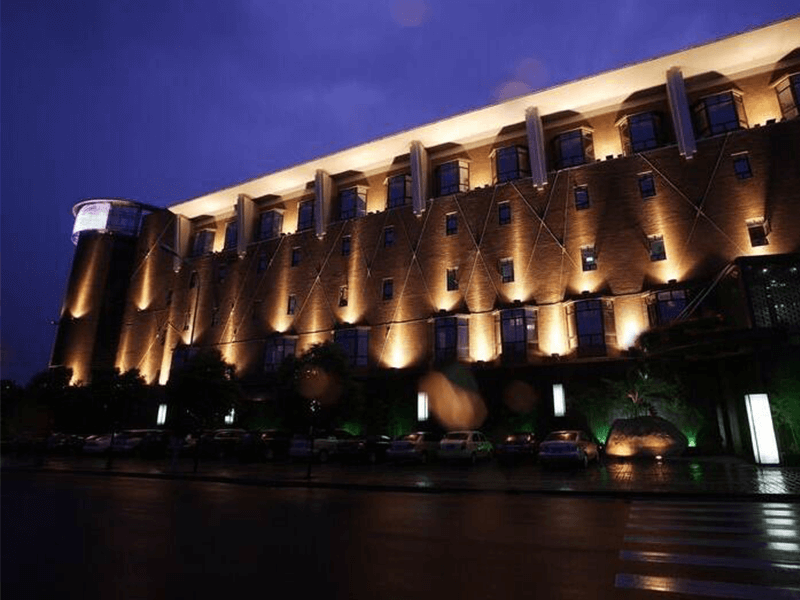Solid Facade
A solid facade, characterized by its smooth and undecorated surface, is a fundamental component in many buildings. These facades typically lack intricate designs or patterns and offer a blank canvas for architectural and lighting interventions. While they may not have inherent design variations, solid facades provide ample opportunities for creative lighting techniques, mainly through natural lighting.
Given their large and unobstructed surfaces, solid facades can effectively accommodate various types of facade lighting. Designers can experiment with lighting temperatures, intensities, and variations to create visually stunning effects. By strategically placing light fixtures and employing lighting control systems, solid facades can be transformed into spectacular visual displays, enhancing the overall aesthetic appeal of the building.
One approach for solid facades is to leverage natural lighting techniques. Designers can utilize sunlight to cast dynamic patterns and shadows on the facade throughout the day. This can be achieved by incorporating architectural elements such as protrusions, recesses, or fins that interact with the sun’s changing position. As the sunlight interacts with these elements, it creates a play of light and shadow, adding depth and visual interest to the otherwise smooth surface.
In addition to natural lighting, artificial facade lighting can also be employed to enhance the appearance of solid facades. By strategically placing light fixtures along the facade, designers can highlight specific architectural features or create a uniform light wash across the entire surface. This allows for manipulating the facade’s perception, emphasizing certain areas, or creating balance and harmony.
The versatility of solid facades extends beyond the choice of lighting temperature and variation. Designers can explore using color-changing LED lights to create dynamic and eye-catching effects. The facade can transform dramatically by programming the lights to transition between different colors or intensities, capturing attention and setting a distinct ambiance.
Furthermore, designers can incorporate other elements into the facade lighting scheme, such as projections or interactive displays. These additions can introduce a layer of interactivity, allowing the facade to engage with its surroundings or respond to user input, creating a memorable and immersive experience.
Vertically Divided Facade
Vertical division facades present a distinct architectural character with their vertical structure, demanding careful consideration in lighting design. To enhance the visual impact of these buildings, designers often choose narrow-beam lighting options that allow for precise illumination. The vertical divisions within the facade create an opportunity to accentuate the architectural elements and emphasize the separation between different sections, resulting in a visually dynamic and captivating exterior. By strategically incorporating techniques such as downlights and uplights, the vertically divided facades can be further enhanced, adding depth and dimension to the overall lighting scheme.
Furthermore, the installation of downlights and uplights can be employed to elevate the visual impact of vertically divided facades. By strategically placing these lighting fixtures, designers can accentuate the architectural elements and create a captivating play of light and shadow. Downlights can be positioned to highlight specific areas or architectural details, while uplights can add a subtle and dramatic effect by illuminating the vertical surfaces. This combination of downlights and uplights adds depth, texture, and visual interest to the vertically divided facades, enhancing their overall aesthetic appeal.
Horizontallly Divided Facade
The horizontal facade contrasts with vertically divided facades, offering a unique canvas for creative lighting designs. With horizontal divisions, designers can play with light and shadow, creating intriguing and captivating visual effects. As the light casts its glow on the horizontal surfaces, it generates elongated shadows that add depth and texture to the facade. These shadows not only enhance the architectural features but also contribute to the overall aesthetics of the building, making it visually striking and engaging. The dynamic interplay of light and shadow on the horizontal facade results in a captivating lighting design that leaves a lasting impression on observers.
Nevertheless, the installation of lights in horizontal divisions can pose particular challenges due to the intricate nature of the installation areas. However, overcoming these difficulties can significantly enhance the overall appearance of your building.
However, effectively reducing the presence of shadows makes it possible to illuminate the building, accentuating its appealing architectural elements and achieving a more harmonious and balanced look in the surrounding environment.
Perforated Facade
A perforated facade provides ample opportunities for creative lighting solutions, enabling designers to seamlessly integrate different types of light fixtures into the surroundings. The perforations allow for the play of light and shadow, creating unique patterns and textures that enhance the visual appeal of the building. By strategically placing and arranging light fixtures, the perforated facade can be transformed into a stunning visual display, making the building stand out and captivating viewers.
Designing lighting for perforated facades requires careful consideration and planning due to the challenges of blending different types of lighting. Factors such as energy efficiency, project size, and maintenance costs are essential considerations in planning. Additionally, the shape and design of the lights should be considered to ensure they complement the overall architecture of the building. Achieving a visually captivating and harmonious lighting design for perforated facades requires meticulous planning and careful attention to detail.
